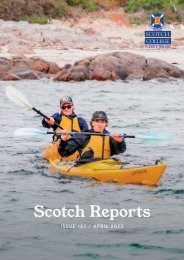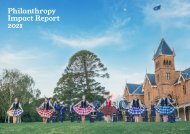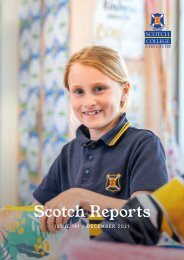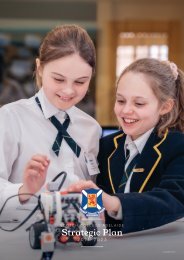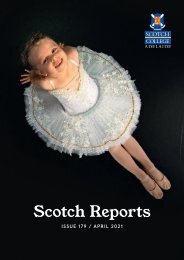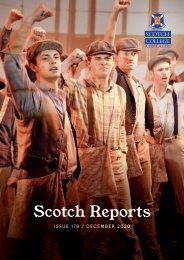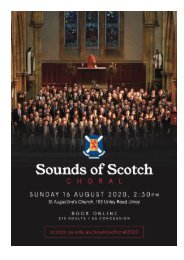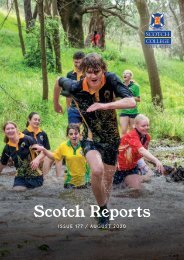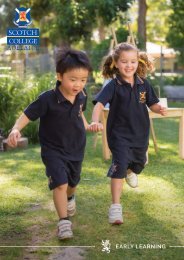Scotch Reports Issue 174 (April 2019)
In the first edition for 2019, we hear from Dr Newton, each of our Scotch campuses, plus a Scotch story from Andrew Saies and all of the Class of 2018 results and destinations. There are also articles from Head of Community, Natalie Felkl and a bumper Straight Scotch covering all things OC and a look back on 2018 OC reunions.
In the first edition for 2019, we hear from Dr Newton, each of our Scotch campuses, plus a Scotch story from Andrew Saies and all of the Class of 2018 results and destinations. There are also articles from Head of Community, Natalie Felkl and a bumper Straight Scotch covering all things OC and a look back on 2018 OC reunions.
Create successful ePaper yourself
Turn your PDF publications into a flip-book with our unique Google optimized e-Paper software.
01<br />
02<br />
04<br />
03<br />
Online Platforms<br />
Whether or not Moore’s Law (the doubling<br />
of computer processing speed/power<br />
every 18 months – 2 years) holds true,<br />
it goes without saying that technology<br />
advancement in education is an exciting<br />
and rapidly developing space. Our students<br />
use technologies such as robotics, 3D<br />
printing, augmented reality, VR and<br />
applications that weren’t readily available<br />
to children in schools only ten years ago.<br />
The constant evolution of technology keeps<br />
us questioning our selection of digital<br />
technologies and importantly, our purpose<br />
in using it.<br />
When drawing on technology as a learning<br />
tool, teachers consider whether it is to<br />
simply substitute for something that does<br />
not require technology? An example of<br />
this is word processing. Or is it to augment<br />
a task, adding functional improvement,<br />
such as using the tools in Google Maps to<br />
calculate distance and time between two<br />
locations on a map? Is the purpose of the<br />
digital technology to modify a learning<br />
experience? Students may be recording<br />
their understanding of a concept with a<br />
verbal explanation rather than undertaking<br />
a ‘test’ and uploading it to the teacher.<br />
Even better, digital technology can allow<br />
teachers and students to redefine learning.<br />
That is, using the technology to create<br />
tasks previously inconceivable, such as a<br />
virtual fieldtrip.<br />
One of the most powerful uses of<br />
technology is where we can use it<br />
to improve (but not replace) human<br />
connection. Over the past few years we<br />
have been introducing the use of Seesaw,<br />
a platform for student-driven digital<br />
portfolios, across Mitcham Campus. Using<br />
Seesaw, children share pictures and videos<br />
with their parents and receive validation (in<br />
the form of comments and feedback) for<br />
the work that they share. Seesaw provides<br />
a wider sense of audience for work as<br />
children document their learning. It also<br />
helps capture and celebrate the learning<br />
process, not just the end result. Students<br />
can use built-in audio recording and<br />
drawing tools to reflect on what they have<br />
learned or explain how they got an answer.<br />
Further benefits of a digital portfolio<br />
include the encouragement children get<br />
from parent comments and the ability to<br />
cross language barriers for families who<br />
speak English as an additional language.<br />
Through our staff Action in Learning<br />
research, Seesaw has now been rolled<br />
out across all year levels as a simple way<br />
for teachers and students to create,<br />
capture and share what's happening in the<br />
classroom during the week.<br />
When students reach the upper primary<br />
years, they are also introduced to SEQTA,<br />
an online Learning Management System<br />
that is used up to Year 12 at <strong>Scotch</strong>. They<br />
begin to upload assessments, which can be<br />
seen at home, and receive some of their<br />
teacher's feedback electronically.<br />
In their final year at Mitcham Campus<br />
students also join ‘Yammer’. Yammer is<br />
a private platform for enterprise social<br />
networking, run as a part of the Office<br />
365 suite of tools. This closed and private<br />
network gives our students meaningful,<br />
guided and monitored experience in a<br />
social media environment before they<br />
reach 13 years of age – the minimum<br />
age for signing up with social media<br />
accounts, such as Instagram, Snapchat,<br />
Facebook, et al. Teachers are assigned<br />
to the Yammer groups that students join.<br />
Our Year 6 Student Action Teams and<br />
Student Leadership groups use Yammer<br />
to plan, organise and run initiatives. It is<br />
exciting to see them using this platform<br />
in such a positive and productive way,<br />
helping to shape their future social media<br />
interactions.<br />
IEVA HAMPSON<br />
Head of Mitcham Campus<br />
01 Year 2 Maths investigation shared on Seesaw<br />
/ 02 Student initiative on Yammer / 03 Year Six<br />
student leaders on 'Yammer' / 04 Sharing an<br />
incursion with Year 1 families<br />
13




